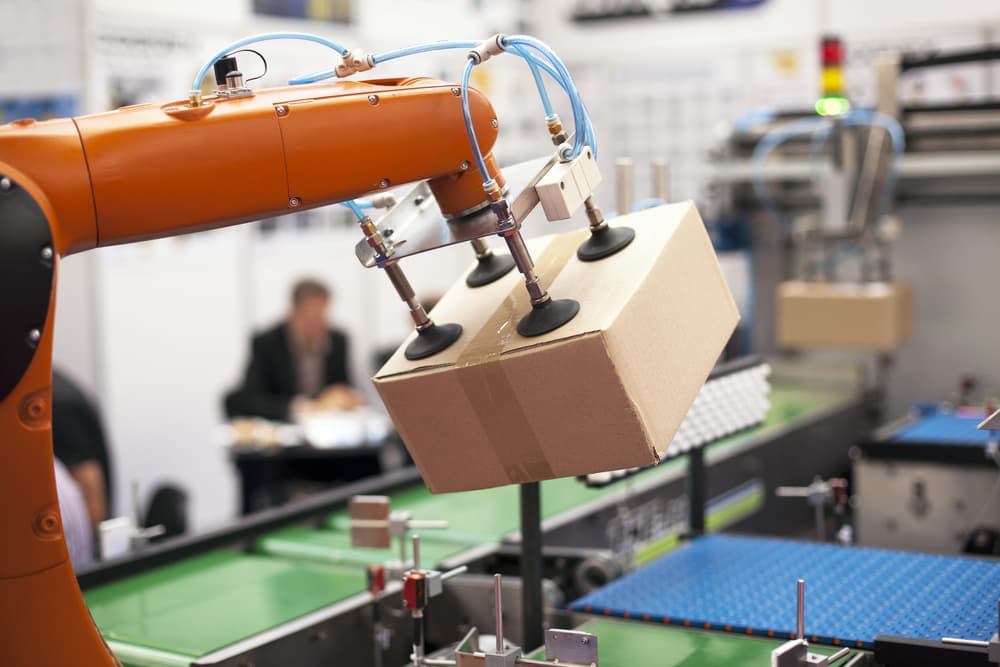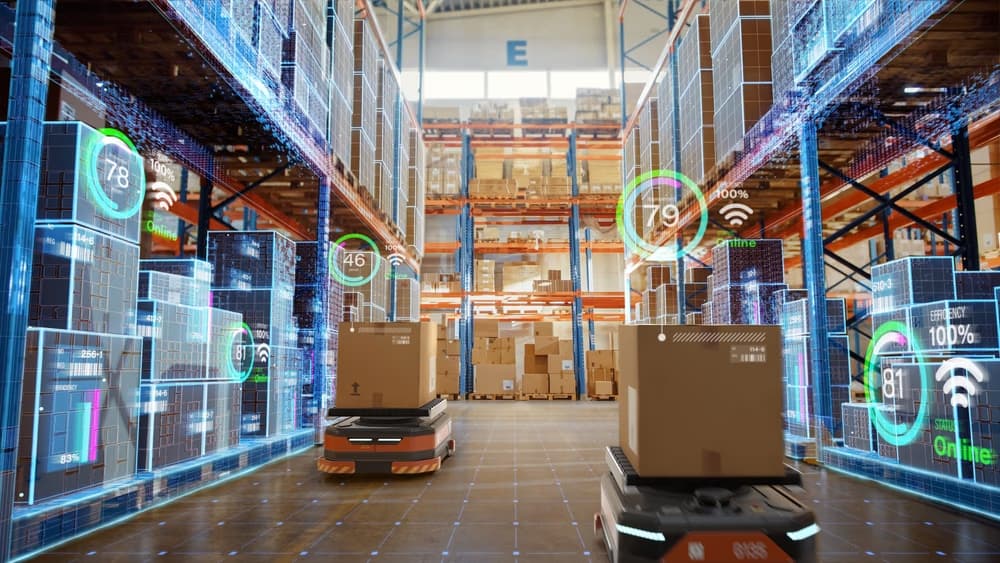Warehouse automation technologies can revolutionize how you manage inventory, optimize resources, and oversee your operations.
Warehouse automation has emerged as a game-changer for business owners, warehouse managers, and logistics management professionals.
By tapping into the power of warehouse automation systems, you can remove friction from your workflows, achieve superior inventory visibility, conquer operational challenges, and better serve your clients.
What is warehouse automation?

Warehouse automation is the process of accelerating the flow of inventory into, within, and out of your warehouses using automation technologies. An automated warehouse system aims to reduce or eliminate the need for labor-intensive processes and minimize human intervention.
Warehouse automation leverages software, such as a warehouse management system, and hardware, such as autonomous robots, to replace manual tasks. Tasks you can automate with warehouse automation systems include the following:
- Receiving
- Picking
- Packing
- Sorting
- Storing
Minimizing manual tasks allows your facility to do more with less, decreasing the likelihood of human error and increasing overall output.
Types of warehouse automation
Warehouse automation can be grouped into two primary categories: digital automation and physical automation.
Digital automation uses warehouse management systems and other software solutions to manage data and eliminate manual workflows. These automation solutions typically address back-office processes, such as developing picking orders and processing incoming requests.
By contrast, physical automation uses technology to reduce employee movement and increase efficiency on the warehouse floor.
For instance, your warehouse could acquire autonomous robots to assist with receiving and loading processes. Instead of loading heavy packages manually, your workers could use the robot to do the heavy lifting. As the robot moves boxes, your software will track each movement and update your inventory to keep records current.
Benefits of warehouse automation
Warehouse automation provides many benefits for you, your business, and your team, including the following:
- Better resource allocation: Warehouse automation technologies allow you to optimize your resource allocation and better meet your warehouse's needs.
- Fewer human errors: Combining physical and digital automation technologies reduces human errors drastically and helps you better serve your customers.
- Lower labor and operational costs: Robots and other automation tools let you do more with less, resulting in reduced labor and operating costs.
- Accelerated warehouse processing: With automation technologies, your warehouse can efficiently receive, process, and fulfill orders in less time.
- Reduced risk of injuries: Workers can leverage robots and goods-to-person technologies instead of lifting heavy packages on their own, reducing their risk of injury.
- Greater accuracy: Automating redundant processes improves fulfillment accuracy and increases customer satisfaction.
- Enhanced inventory management: You can reduce human error and gain better visibility over your inventory through automation.
These are just some of the many benefits associated with warehouse automation technologies that will lead to better customer satisfaction, improved operational efficiency, and increased revenue.
Categories of warehouse automation
There are varying degrees of warehouse automation, ranging from relatively simple to highly complex. The four categories of warehouse automation include:
- Basic warehouse automation: These automations assist your staff with tasks that require manual labor, such as using a conveyor to move inventory.
- Warehouse system automation: System automations rely on machine learning and data analytics to automate order processing and other back-office processes.
- Mechanized warehouse automation: Robotic equipment can assist your team with daily tasks, such as loading shelves and picking orders.
- Advanced warehouse automation: This combines multiple types of automation to streamline entire workflows.
You probably already use some of the primary forms of warehouse automation. You can automate additional processes and further refine your workflows by implementing more sophisticated solutions.
7 examples of warehouse automation technology
There are many types of warehouse automation technology, including the following:
1. Goods-to-person (GTP) technologies
GTP technologies are among the most common automation solutions in the modern warehouse. These technologies include carousels, vertical lift systems, and conveyors.
2. Automated storage and retrieval systems (AS/RS)
AS/RS technologies store and retrieve raw materials or products. This technology category includes material-carrying vehicles, mini-loaders, and tote shuttles.
3. Automatic guided vehicles (AGVs)
AGVs use wires, sensors, or magnetic strips to navigate a pre-built path through a warehouse. These machines are limited to simple, open warehouse environments with plenty of space. They aren’t a good fit for crowded warehouses or those with complex layouts.
4. Autonomous mobile robots (AMRs)
AMRs are the cutting edge of warehouse automation. These robots use maps and sensors to create dynamic routes through your warehouse and employ laser guidance systems to avoid obstacles. They can support various picking, packing, and retrieval functions.
5. Pick-to-light and put-to-light systems
These systems use digital light displays and barcode scanning devices to direct warehouse pickers where to pick up or place items.
6. Voice picking and tasking
These solutions use voice recognition technologies and mobile headsets to expedite picking. They direct warehouse workers where to put away or pick products. Once a task is complete, workers relay this information using their headsets and receive their next assignment.
7. Automated sortation systems
Automated sortation systems use RFID or barcode scanners and sensors to identify items as they travel along conveyor systems. The items are then diverted to the appropriate location within the warehouse.
When to automate your warehouse

If you’re considering automating your warehouse, ask yourself the following questions:
- Are my customer orders frequently delayed due to staffing limitations?
- Is my order fulfillment capacity stagnant or declining?
- Is there a bottleneck in my supply chain?
- Would my stakeholders support a significant automation project?
- Are my inventory counts unreliable?
When resource management becomes unwieldy and the customer experience suffers, it’s time to automate. That said, you must ensure your stakeholders are on board before you commit to a major project. Keep your staff in the loop so they know what changes are coming down the pipeline.
Tips and best practices for warehouse automation
Before you start searching for warehouse automation companies and technologies, you must set the stage for a successful automation initiative.
Optimizing data receiving
Do you have a streamlined process for receiving data from consumers and trading partners? If not, you must implement a new solution, like an API-powered EDI communication platform. You must ensure streamlined communication with clients and partners before you automate workflows.
Automating data collection
It's best to also automate your data collection processes. If your staff has to manually collect and enter data, they will have trouble integrating automation processes into their workflows.
Investing in a warehouse management system
A warehouse management system provides a holistic view of your warehouse and business performance. Once you better understand your operations, you can identify when and where to incorporate automation technologies.
Support your warehouse automation journey with Orderful
Maximizing supply chain visibility is another way to prepare your business for automation. Achieve this by streamlining communication between your company and trading partners with a modern, cloud-based EDI solution like Orderful.
Orderful facilitates frictionless communication and lets you easily share data with your trading partners. To learn more, contact us and speak to an EDI expert.
- 01What is warehouse automation?
- 02Types of warehouse automation
- 03Benefits of warehouse automation
- 04Categories of warehouse automation
- 057 examples of warehouse automation technology
- 06When to automate your warehouse
- 07Tips and best practices for warehouse automation
- 08Support your warehouse automation journey with Orderful
